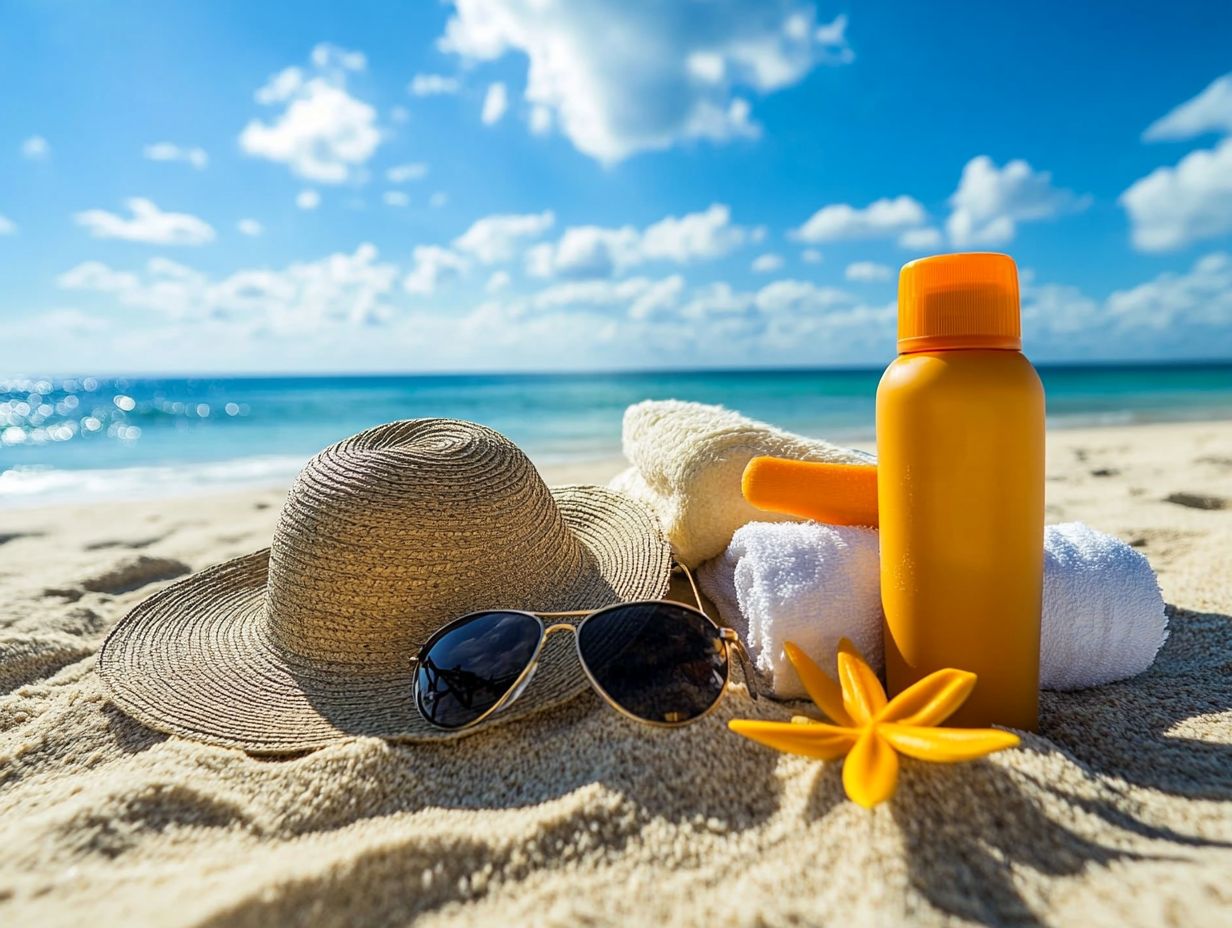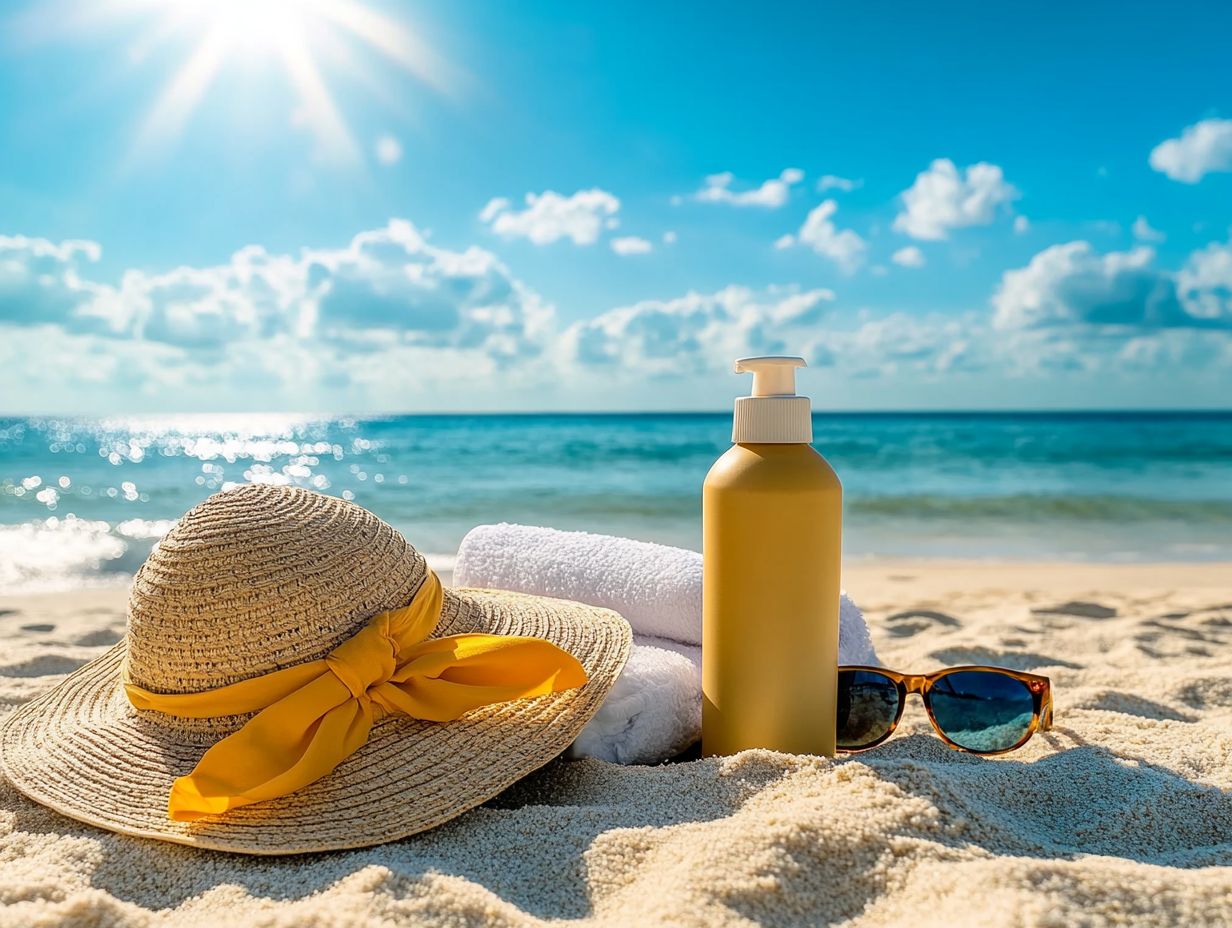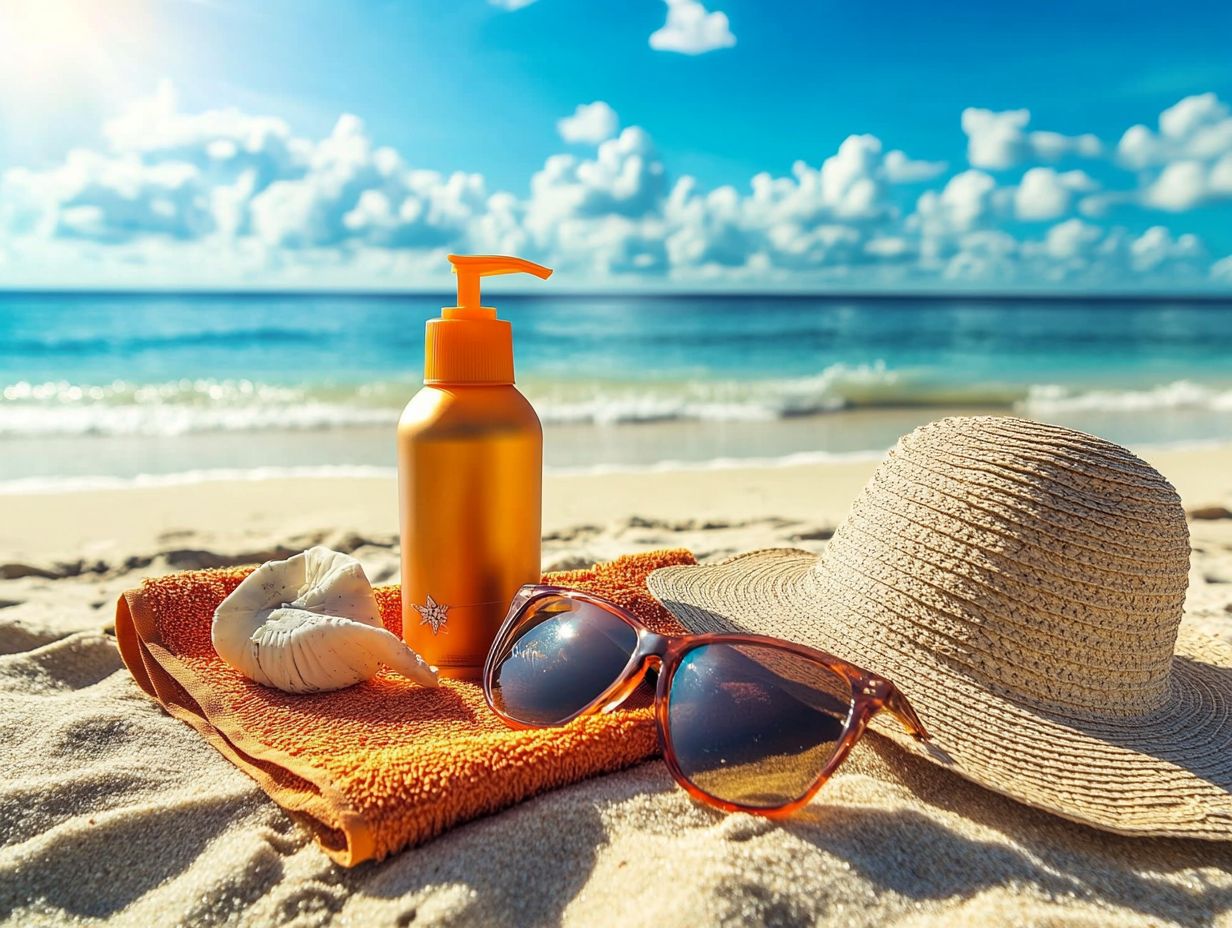Sunscreen is an essential component of my skincare routine, providing crucial protection against harmful UV rays that can lead to skin damage and elevate the risk of skin cancer.
With a plethora of options and varying SPF levels available, I often find navigating the world of sunscreen to be quite confusing. This article aims to clarify the core concepts of sunscreen and SPF, detailing how they work to protect my skin while guiding me in selecting and applying the right product effectively.
Moreover, it addresses common myths surrounding sunscreen and offers additional tips for comprehensive sun protection. By equipping myself with this knowledge, I can promote healthier, happier skin.
Key Takeaways:
Understanding Sunscreen and SPF

Understanding sunscreen and SPF is essential for effective sun protection, as it significantly contributes to maintaining skin health against harmful UV rays that can lead to skin cancer.
Sunscreen, available in various formulations such as mineral and chemical types, is designed to provide broad-spectrum protection against both UVA and UVB rays.
I recognize the importance of daily sunscreen application as a fundamental aspect of a comprehensive skincare routine. I also emphasize the significance of understanding SPF ratings and selecting the appropriate sunscreen products tailored to individual skin tones and types.
What is Sunscreen?
Sunscreen is a topical product that I utilize to protect my skin from the harmful effects of sun exposure, particularly the UV rays that can lead to skin damage and increase the risk of skin cancer.
Understanding the different types of sunscreen is essential for effective skin protection. There are primarily two formulations: mineral and chemical sunscreens.
Mineral sunscreens, which often contain active ingredients like titanium dioxide and zinc oxide, function by physically blocking UV rays from penetrating the skin. On the other hand, chemical sunscreens absorb UV radiation through their chemical ingredients, which can sometimes lead to irritation for those with sensitive skin types.
Regardless of the formulation I choose, I recognize that regular application is paramount; it not only helps maintain my skin health but also plays a significant role in preventing premature aging and skin conditions associated with sun exposure.
What is SPF?
SPF, or Sun Protection Factor, is a numerical rating that indicates the level of protection my sunscreen provides against sunburn caused by UVB rays. Essentially, it measures how long I can stay in the sun without burning.
For instance, using an SPF 30 sunscreen theoretically allows me to remain in the sun 30 times longer than I could without any protection. On the other hand, an SPF 50 offers slightly more coverage, extending this duration to 50 times. However, the actual difference in protection may not be as significant as the numbers imply. SPF 30 blocks about 97% of UVB rays, while SPF 50 blocks approximately 98%. This subtle distinction suggests that although both options provide considerable sunburn prevention, my choice might depend on factors such as my skin type and the duration of sun exposure.
Dermatologists frequently advise that I combine SPF use with other sun safety strategies. This includes:
- Seeking shade
- Wearing protective clothing
- Reapplying sunscreen every two hours—especially after swimming or sweating
to maximize skin protection and minimize the risk of damage.
How Sunscreen Protects Your Skin

I understand that sunscreen is essential for protecting my skin by creating a barrier that deflects and absorbs harmful UV rays.
These rays can cause skin damage, contribute to premature aging, and increase the risk of skin cancer.
By effectively blocking both UVB and UVA rays, I recognize the crucial role sunscreen plays in maintaining skin health and preventing the long-term effects of sun exposure.
Types of UV Rays
I recognize that there are two primary types of ultraviolet (UV) rays that impact the skin: UVA rays, which largely contribute to skin aging and wrinkle formation, and UVB rays, which are the primary cause of sunburn and play a significant role in the risk of skin cancer.
Understanding the unique characteristics of these rays is essential for effective skin protection. UVA rays penetrate deeply into the skin, resulting in collagen breakdown, while UVB rays primarily target the surface layers, leading to damage such as redness and blistering.
According to the American Academy of Dermatology, UV exposure accounts for approximately 90% of skin aging and increases the chances of developing skin cancer, with statistics indicating that 1 in 5 Americans will face this diagnosis in their lifetime.
Dermatologists strongly advocate for the daily application of sunscreen, emphasizing that broad-spectrum protection can significantly reduce the harmful effects of both UVA and UVB rays, ultimately helping to preserve healthy, youthful skin.
How Sunscreen Blocks UV Rays
Sunscreen functions by utilizing active ingredients to either absorb or reflect UV rays, effectively blocking harmful radiation that can lead to skin damage and skin cancer.
Chemical sunscreens typically contain organic compounds that absorb UV radiation, converting it into heat and then releasing it from the skin. In contrast, mineral sunscreens use physical compounds such as titanium dioxide and zinc oxide, which remain on the skin’s surface and reflect UV rays away. For more information, check out Everything You Need to Know About Sunscreen (SPF Basics).
These mineral ingredients are well-regarded for their broad-spectrum protection, effectively shielding the skin from both UVA and UVB rays. It is crucial to reapply sunscreen every two hours, particularly after swimming or sweating, to maintain maximum effectiveness and ensure continuous protection against potential skin damage.
Choosing the Right Sunscreen

Selecting the appropriate sunscreen is crucial for optimizing skin protection, and it requires careful consideration of several factors, including skin type, the desired SPF level, and specific skin concerns such as hydration or anti-aging.
Factors to Consider
When selecting a sunscreen, I understand the importance of considering several factors, including my specific skin type, the level of SPF protection required, and whether I prefer a formulation that offers hydration.
For example, those of us with oily skin may find that lightweight, oil-free formulations provide effective sun protection without adding excess shine. On the other hand, individuals with dry skin should opt for sunscreens that include hydrating ingredients to help maintain moisture while effectively blocking harmful UV rays.
For sensitive skin types, mineral-based sunscreens often prove to be less irritating and more suitable. Additionally, recognizing my skin tone plays a crucial role in selecting the appropriate sunscreen; while darker skin tones may have a lower risk of sunburn, they still require protection against UV damage. Conversely, those with lighter skin tones generally need higher SPF levels to prevent burning.
Personalizing sunscreen choices based on these factors is essential for maintaining healthy skin while enjoying outdoor activities.
Proper Application of Sunscreen
I understand that the proper application of sunscreen is essential for effective sun protection. This involves applying an adequate amount evenly over all exposed skin areas, ideally about 15 minutes before sun exposure.
Additionally, I make it a point to reapply every two hours or immediately after swimming or sweating to ensure optimal protection.
How Much to Apply and How Often

To ensure maximum protection, I recommend applying approximately an ounce of sunscreen to all exposed areas of the body and reapplying every two hours, or immediately after swimming or excessive sweating.
Integrating sunscreen into my daily skincare routine is both seamless and effective. I start by applying a broad-spectrum sunscreen with at least SPF 30 right after my moisturizer in the morning.
For those who wear makeup, I suggest using a tinted sunscreen or a setting spray with SPF for added convenience. It’s essential for me not to overlook areas such as the ears, the back of the neck, and the tops of the feet.
Setting reminders on my phone helps me maintain consistent reapplication throughout the day, especially during outdoor activities. By making sunscreen a non-negotiable part of my daily regimen, I can enjoy sun exposure with confidence while protecting my skin from harmful UV rays.
Common Misconceptions About Sunscreen
I have observed several common misconceptions about sunscreen that can result in inadequate sun protection.
Many individuals believe that sunscreen is only necessary on sunny days or that a higher SPF always equates to better protection against skin cancer.
Debunking Myths and Misinformation
Many myths about sunscreen continue to circulate, including the belief that individuals with darker skin tones do not require sunscreen. This misconception can lead to a heightened risk of skin damage and skin cancer.
This notion is particularly concerning, as research indicates that while darker skin contains more melanin and offers some natural protection, it does not grant complete immunity against the harmful effects of UV rays. Experts consistently highlight that everyone, regardless of their skin tone, should apply sunscreen with a broad-spectrum SPF of at least 30 on a daily basis.
According to the Skin Cancer Foundation, 1 in 5 Americans will develop skin cancer by the age of 70, which underscores the urgent need for proactive sun protection measures.
It is crucial for individuals to recognize that sun safety is a universal requirement, reinforcing the idea that protective practices should be an essential part of everyone’s skincare routine.
Tips for Sun Protection Beyond Sunscreen
Along with applying sunscreen, I implement several effective strategies for sun protection. These include:
- Wearing protective clothing
- Seeking shade
- Avoiding sun exposure during peak hours to minimize harmful effects
Other Ways to Protect Your Skin from the Sun
To effectively protect my skin from the sun, I make it a point to incorporate additional methods, such as wearing UV-blocking sunglasses, donning wide-brimmed hats, and selecting clothing specifically designed for sun safety. These accessories not only complement my style but also provide essential barriers against harmful UV rays.
I opt for long-sleeve shirts made from lightweight, breathable fabrics that are rated for UV protection, preferably in darker colors that absorb sunlight more effectively. Staying hydrated is also crucial; I ensure I drink plenty of water throughout the day to help my skin maintain its elasticity and resilience against sun damage.
I find it prudent to limit outdoor activities during peak sun hours, typically between 10 a.m. and 4 p.m., to minimize the risk of overexposure. By adopting a balanced approach to sun safety, I can enjoy outdoor activities while significantly reducing the risks associated with UV radiation.


